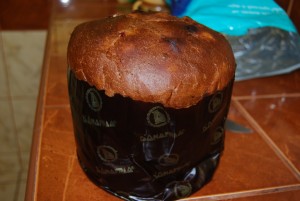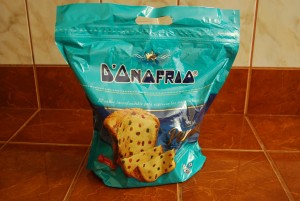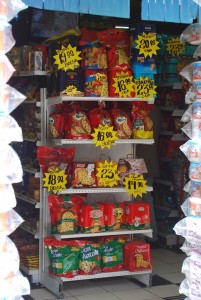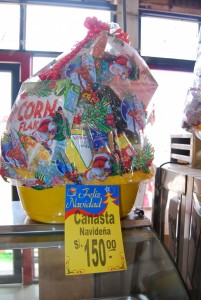Sweet Bread and Christmas in Cuzco

A tall wedge of lightly citrusy bread laden with colorful fruit goes with Christmas in Peru, like the Inca Pachacutec goes with Cuzco. Just as his statue and image is found in many places in the city, so Cuzqueños and Peruvians everywhere will lift that wedge to their mouths before sipping hot chocolate on Christmas Eve. It is tradition, but one that is filled with the complexity of Peruvian history.
Called “panetón”–or “big bread”–this bread is so Peruvian that it invokes images of Machu Picchu, soaring condors, and of course the Incas. But it originates in northern Italy, specifically in the industrial city of Milan famous for its fashion industry and its secular communists.
It is one of an encyclopedia of fruited sweetbreads from Europe that came to accompany Christmas. In older generations in the English-speaking world a dense loaf filled with fruit and often rum was the bread. It is heavy and dense. But the panetón is light and airy. While the English loaf is short and squat, the Italian soars as if a cloud rising to the horizon.
Though probably having roots in the folk culture of the Italian Piedmont, the panetón, or panettone in Italian, became an industrial product in the early twentieth century. It thus became something one bought and ate like everyone else, instead of something individually produced, or made in small local bakeries, and infinitely varied. It was a mass commodity and quickly became required for Christmas celebrations.
Though conceptually the Italian and Spanish worlds are separate, they are also deeply intertwined. Spain ruled large parts of Italy for much of the last half of the last millennium and Italians were among the first European settlers of Peru, along with other from the domains of the Spanish crown.


After Peru became independent, Italians continued coming. From the latter half of the nineteenth through the early twentieth centuries this immigration surged. In this, Peru was like the rest of the new world which received tens of millions of European migrants. But in Peru the Italians became the largest European population and had a lasting impact on the country and its cuisine.
Italian immigrants tended to be more educated than the rest of Peru. They settled mostly in the coastal cities and became shop keepers and businessmen. However some of them also became industrialists at the time when the mass culture so feared by Spanish speaking intellectuals such as Ortega y Gasset was developing all over the world through the growth of cities.
Antonio D’Onofrio, the son of Italian immigrants from Caserta established a company specializing in chocolate, ice cream, and panetón. D’Onofrio´s products spread through neighborhood store after neighborhood store, many of them in the cities run by fellow Italians, until they became ubiquitous in urban Peru and in Peru’s overseas diaspora.
Many others now make panetón, but the tall blue package of a D’Onofrio panetón is iconic, though other companies also make and market panetones. The multinational giant Nestlé, which now owns D’Onofrio, markets the Peruvian panetón throughout Latin America and elsewhere in the world. While especially prized by Peruvian émigré communities, many other people are finding it delicious.
(Not only is it good as is for Christmas, I can say it also makes amazing french toast for one of the days after Christmas.)

Of course there must be some controversy. Italian bakers are working to obtain a Denomination of Origin for the panettone which leads to conflict with South American bakers, like D’Onofrio over the legitimacy of Peru’s recipe and use of the name panetón. While the main issue may be sales of Italian branded products in the United States market, this conflict promises to impact the internal Peruvian market as well. The end of this struggle between the homeland and diasporic communities over a name and its relationship to a product and recipes for it will not end soon.
In Peru the custom of eating panetón for Christmas is an urban custom that has followed the growth of cities and the development of mass markets for food products. Rural Peru still has different customs. Their calendar of feasts and the kinds of rituals done on them varies from that of the cities, although urban Peru is increasingly impacting them, especially since the majority of their children take up residence in the cities and then bring the city culture back home when they visit.

Ethnographer Inge Bolin while writing about a highland community up the Vilcanota Valley from its confluence with the Watanay which drains the Cuzco Valley observes that neither Christmas nor Easter–two of the main festivals of urban life– are celebrated there. Called Chillihuani, the community has a rich festive life with customs that in many cases stem from pre-Columbian times. But urban culture is only slowly beginning to influence the community, in part because of immigrants but also because of public education. Nevertheless, Chillihuani like much of rural Peru remains a hold out from the mass culture of Christmas with its Italian-Peruvian panetones.

In the city of Cuzco, supermarkets, markets, and neighborhood stores are filled with piles of panetones in brightly colored boxes, like Christmas gifts. In fact business will give their employees a basket of goodies generally including panetones. On the twenty-forth of December, as midnight approaches, about the time the Christ Child is placed in the manger in the nativities in almost every home, people will share hot chocolate and pantetón while from his perches in the city Pachacutec looks on




